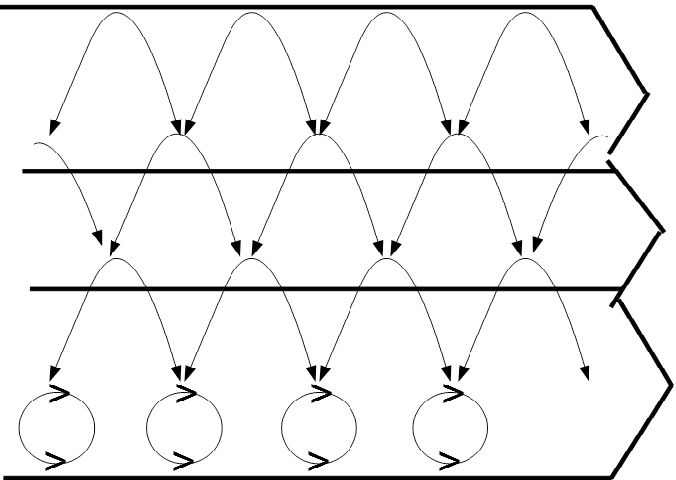Pt. 2

Givenness is a veil. As proof, the first words of Emmanuel Levinas’s Totality and Infinity chop and screw Rimbaud’s oft-quoted “The true life is elsewhere. We are not in the world.” For Levinas, it’s a crucial corrective: “‘The true life is absent.’ But we are in the world.”[1] Truer words were never slowed and throwed. We are, of course, always already drowning in a world that swallows us into the folds of its becoming(s) (that is, whatever world is hungry for us today); as subjects, we’re thrown (“sub-”: under / “-ject”: to throw) into worlds of our own making and thrust against other(’s) worlds impinging on (or conversely, intensifying) our inchoate potential, swirling about the collaborative interplay of novelty, concrescence and transition. There’s the world we have (we think): the world we believe we possess and can alter and will ultimately “master” whilst being-towards-death; there’s the world we want; the world we would rather occupy; the world we knew (perspectively) as it was then (and as it is for us now); the world for me, the world for you, the world in which our worlds meet. To-be-in-world means to be thrust into Benjamin’s lighting flash (or at least its afterimage), a superjective dialectical image of ourselves as objects (ek-statically so) pacing around the world as it builds and morphs and dashes itself to pieces around us, only to twist into some alien configuration in which we no longer recognize ourselves only to fully become ourselves.
Whichever world builds around us, we engage only with the disinhibiting ring of our solipsistic umwelts (Jakob von Uexküll’s “environments”), in which we are neither really subject nor superject, but always becoming somewhere in between concrescence and transition, peeking out of nunc stans (“now time”) for a moment as the shit collapses around us — captivated by the blur of frames moving so quickly as to make the transformation from vibrant subject-configuration to ossified caricature a single, seamless moneyshot. In short, we experience world as an ecological unity, “a unity of immediacy,” what Whitehead ultimately calls “the unitexturality of reality,” as if it were real, fixed, fated. Amor fati, I guess, or else ...
Levinas understood, however, that there’s an open beat of potential between each concretized moment: the true life might be elsewhere, yes, but our bridge to the real is from the temporary, uneven footing of our compromised now. If we seek access to the outside (if there is such a thing) we have to somehow peek through the veil of a diagrammatic still, a fixed image of the whole in which we always already find ourselves. Vincent Vycinas claims in his Heideggerian study Earth and Gods:
Traditional philosophy does not come upon the problem of the world because it does not think primarily enough. Dealing with the beings as disposables, it can never encounter the world itself, which is prior to beings and is always presupposed by them. Things are always within the world; without the world they cannot be encountered.[2]
But this is only partially true because the world is made, just like any other made thing: collectively made, collectively interpreted, collectively forgotten. Levinas tries to clarify how to world (verb) by juxtaposing “worlding” with his concept of “the element”:
The medium has its own density. Things refer to possession, can be carried off, are furnishings [think here of Spicer’s “furniture”]; the medium from which they come to me lies escheat, a common fund or terrain, essentially non-possessable, ‘nobody’s’: earth, sea, light, city. Every relation or possession is situated within the non-possessable which envelops or contains without being able to be contained or enveloped. We shall call it the elemental. [...] To tell the truth the element has no side at all. One does not approach it. The relation adequate to its essence discovers it precisely as a medium: one is steeped in it; I am always within the element. [3]
Levinas uses the concept of the element to highlight the made-ness of world: if the element is matrix — the backdrop of becoming on which world(s) manifests — then world(s) can be better or worse — different; they can be altered, and we can alter them: even us poets. In short, world is not fated or fixed, and peeling it back from the element helps us see that, yes, we are world-beings, but just like our subject-configurations, world-configurations become with us. In the element, world(s), like words, emerge — like subjects, superjects, objects taken for subjects, subjects confused with objects.
Which is all to say, finally, that, in order to write poems, it’s imperative to understand the nature of the world in which and for which they are written, a fact that the majority of our compeers seemingly ignore. When the world appears, it often does so as backdrop, world as matrix rather than world (one possible among many) as palimpsest. World is not a passive backdrop, nor is the poem merely mimetic, perspectival parroting of world. The poet’s responsibility, firstly, is to create some space between element and world and reader and poet: to orchestrate a spatial / temporal / intellective / affective complex. To introduce world to Pierre (the Lucky), so it belongs to the process of polysemous fluorescence rather than mere ambient white noise. As Duncan reminds us in his preface to Bending the Bow,
Working in words I am an escapist; as if I could step out of my clothes and move naked as the wind in a world of words. But I want every part of the actual world involved in my escape. I bring the laws that bound me into an aerial structure in which they are unbound as outlines of a prison unfolding.[4]
1. Emmanuel Levinas, Totality and Infinity: An Essay on Exteriority (Pittsburgh, PA: Duquesne University Press, 2016), 33.
2. Vincent Vycinas, Earth and Gods (The Hague: Martinus Nijhoff, 1961), 34.
4. Robert Duncan, Bending the Bow (New York: New Directions Books, 1968), v.

Prolegomena to (Any Future) Process Poetics